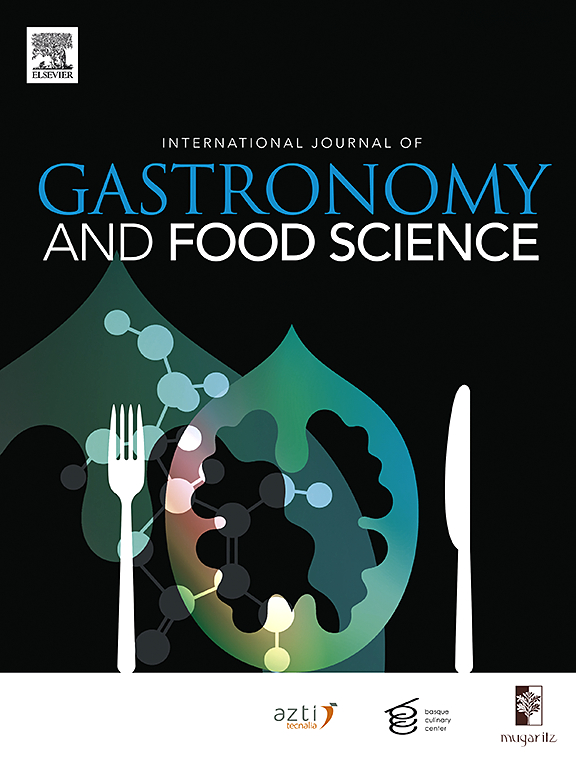Insects in contemporary Mexican gastronomy
IF 3.6
2区 农林科学
Q2 FOOD SCIENCE & TECHNOLOGY
International Journal of Gastronomy and Food Science
Pub Date : 2025-09-15
DOI:10.1016/j.ijgfs.2025.101299
引用次数: 0
Abstract
Currently, edible insects are considered an alternative to large animal protein due to their nutritional and protein content and sustainable production, and their consumption has been promoted by international organizations. However, many societies still reject them. Recent research suggests that encouraging their gastronomic use could be an effective way of increasing their consumption. Mexico, being a country with an entomophagous tradition, becomes an important point of analysis. The objective was to analyse the gastronomic use of insects in contemporary Mexico. An online questionnaire and the Free Word Association tool were used to identify the gastronomic uses of insects. A total of 295 questionnaires were answered. Eight traditional and two transcultural forms of preparation were identified. The consumption of insects is present in traditional spaces such as markets and tianguis, and in gourmet spaces such as restaurants, which contributes to the fact that these foods of pre-Hispanic origin are present today, where the diverse gastronomic proposals can respond to the preferences of consumers seeking new gastronomic experiences with alternative proteins to the conventional ones.
当代墨西哥美食中的昆虫
目前,食用昆虫因其丰富的营养和蛋白质含量以及可持续性生产被认为是大型动物蛋白的替代品,其消费得到了国际组织的推动。然而,许多社会仍然拒绝他们。最近的研究表明,鼓励它们用于烹饪可能是增加它们消费的有效方法。墨西哥作为一个有食虫传统的国家,成为一个重要的分析点。目的是分析昆虫在当代墨西哥的烹饪用途。一份在线问卷和Free Word Association工具被用来确定昆虫的烹饪用途。共回答了295份问卷。确定了八种传统和两种跨文化的准备形式。昆虫的消费存在于传统空间,如市场和天庭,以及美食空间,如餐馆,这有助于这些前西班牙起源的食物出现在今天,在那里,不同的美食建议可以回应消费者的偏好,寻求新的美食体验,用替代蛋白质代替传统的。
本文章由计算机程序翻译,如有差异,请以英文原文为准。
求助全文
约1分钟内获得全文
求助全文
来源期刊

International Journal of Gastronomy and Food Science
Social Sciences-Cultural Studies
CiteScore
5.30
自引率
10.50%
发文量
170
审稿时长
45 days
期刊介绍:
International Journal of Gastronomy and Food Science is a peer-reviewed journal that explicitly focuses on the interface of food science and gastronomy. Articles focusing only on food science will not be considered. This journal equally encourages both scientists and chefs to publish original scientific papers, review articles and original culinary works. We seek articles with clear evidence of this interaction. From a scientific perspective, this publication aims to become the home for research from the whole community of food science and gastronomy.
IJGFS explores all aspects related to the growing field of the interaction of gastronomy and food science, in areas such as food chemistry, food technology and culinary techniques, food microbiology, genetics, sensory science, neuroscience, psychology, culinary concepts, culinary trends, and gastronomic experience (all the elements that contribute to the appreciation and enjoyment of the meal. Also relevant is research on science-based educational programs in gastronomy, anthropology, gastronomic history and food sociology. All these areas of knowledge are crucial to gastronomy, as they contribute to a better understanding of this broad term and its practical implications for science and society.
 求助内容:
求助内容: 应助结果提醒方式:
应助结果提醒方式:


